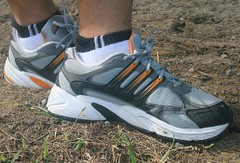This chapter covers the ways in which plants make use of the carbon dioxide from the atmosphere and water from the soil to make food (carbohydrate) with the help of energy from sunlight which is trapped by chlorophyll in the chloroplasts. This is photosynthesis. Apart from this process, this chapter also covers the way in which plants convert this carbohydrate into proteins and other materials by using minerals absorbed from the soil. Before photosynthesis is to be discussed further, we must first pay tribute to the important organ of the plants in which this process occurs, THE LEAF.
The following figure shows the whole structure of a simple dicotyledonous leaf:

Note: Being able to draw a leaf accurately (based on observing a real specimen) is very important and commonly asked in the practical paper. Students should not take the proportion and the number of veins lightly when drawing a leaf. However drawing the vein network is usually not required but if you are asked specifically in the question to draw the vein network, drawing some (at least covering 10% of the leaf) should suffice. AND mind your labelling. By now, you should be able to identify and label the petiole, midrib, veins, lamina, leaf apex and axil
The following figure shows the internal structure of a dicotyledonous leaf (transverse section):


Can you identify the upper and lower epidermal layers, the palisade mesophyll layer, the spongy mesophyll layer and the intercellular air spaces?
The following figure shows the internal structure of a dicotyledonous leaf (3-Dimensional):

Note: Notice the positions of the xylem and the phloem in the vascular bundle. In a leaf the xylem is always above the phloem (And just for comparison: the phloem is on the outer side while the xylem is in the inner side of the stem). Can you visualise how the vascular bundles in the stem are connected to those in the leaves?
The following figure shows the whole structure of a simple dicotyledonous leaf:

Note: Being able to draw a leaf accurately (based on observing a real specimen) is very important and commonly asked in the practical paper. Students should not take the proportion and the number of veins lightly when drawing a leaf. However drawing the vein network is usually not required but if you are asked specifically in the question to draw the vein network, drawing some (at least covering 10% of the leaf) should suffice. AND mind your labelling. By now, you should be able to identify and label the petiole, midrib, veins, lamina, leaf apex and axil
The following figure shows the internal structure of a dicotyledonous leaf (transverse section):


Can you identify the upper and lower epidermal layers, the palisade mesophyll layer, the spongy mesophyll layer and the intercellular air spaces?
The following figure shows the internal structure of a dicotyledonous leaf (3-Dimensional):

Note: Notice the positions of the xylem and the phloem in the vascular bundle. In a leaf the xylem is always above the phloem (And just for comparison: the phloem is on the outer side while the xylem is in the inner side of the stem). Can you visualise how the vascular bundles in the stem are connected to those in the leaves?
